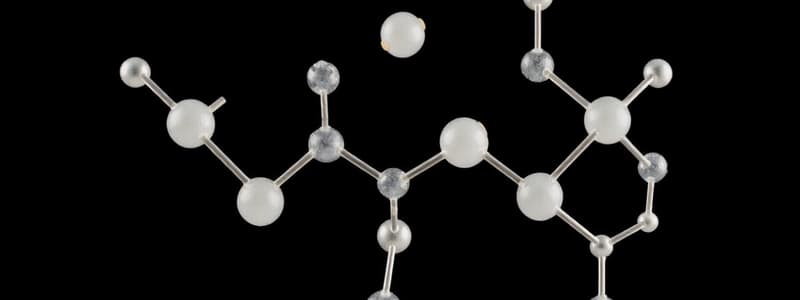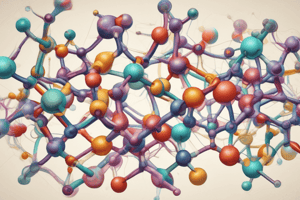Podcast
Questions and Answers
Which of the following statements about reducing sugars is correct?
Which of the following statements about reducing sugars is correct?
- Reducing sugars do not include any polysaccharides.
- Sugars with a free anomeric carbon are reducing sugars. (correct)
- Only oligosaccharides can be reducing sugars.
- Disaccharides are nonreducing if one sugar contains a free anomeric carbon.
Which of the following correctly describes the structures of starch?
Which of the following correctly describes the structures of starch?
- Starch is not digestible by animals.
- Starch has a linear structure with branched chains every 5 to 10 residues.
- Starch is composed of α(1→4) D-glucose chains and α(1→6) D-glucose branches. (correct)
- Starch consists solely of β(1→4) D-glucose chains.
What characterizes the structure of cellulose?
What characterizes the structure of cellulose?
- It is a linear polymer of β(1→4) D-glucose. (correct)
- Cellulose is exclusively made from N-acetyl-D-glucosamine.
- It has both α(1→4) and β(1→4) linkages.
- It consists of branched α(1→6) D-glucose.
Which statement regarding glycogen is accurate?
Which statement regarding glycogen is accurate?
Which type of linkage is associated with N-linked glycoproteins?
Which type of linkage is associated with N-linked glycoproteins?
What distinguishes Gram-negative bacterial cell walls?
What distinguishes Gram-negative bacterial cell walls?
What is the primary function of glycosaminoglycans?
What is the primary function of glycosaminoglycans?
Which of the following correctly describes peptidoglycan in bacterial cell walls?
Which of the following correctly describes peptidoglycan in bacterial cell walls?
Which of the following represents a characteristic of diastereomers?
Which of the following represents a characteristic of diastereomers?
In the context of carbohydrates, what defines an epimer?
In the context of carbohydrates, what defines an epimer?
What configuration of an anomeric carbon indicates an alpha (α) configuration?
What configuration of an anomeric carbon indicates an alpha (α) configuration?
Which of these statements best describes furanose structures in carbohydrates?
Which of these statements best describes furanose structures in carbohydrates?
Which carbohydrate classification refers to a sugar with four carbon atoms?
Which carbohydrate classification refers to a sugar with four carbon atoms?
What is the primary function of the anomeric carbon in carbohydrate chemistry?
What is the primary function of the anomeric carbon in carbohydrate chemistry?
Which of the following best describes the D- and L- configuration of carbohydrates?
Which of the following best describes the D- and L- configuration of carbohydrates?
Which of the following describes glycosides?
Which of the following describes glycosides?
Flashcards are hidden until you start studying
Study Notes
Carbohydrates
- Carbohydrates are based on the formula (CH2O)n, where n is greater than or equal to 3
- Simple sugars are called monosaccharides
- Polymers of simple sugars are called oligo- and polysaccharides
Monosaccharide Classification
- Monosaccharides are classified as aldoses (containing an aldehyde group) or ketoses (containing a ketone group)
- They are also classified based on the number of carbon atoms they contain: triose (3 carbons), tetrose (4 carbons), pentose (5 carbons), hexose (6 carbons), etc.
Stereochemistry
- Monosaccharides with 3 or more carbons (aldoses) and 4 or more carbons (ketoses) have asymmetric carbons (chiral centers)
- D- and L- configurations refer to the configuration of the highest numbered asymmetric carbon
- D- and L- forms are mirror images and are called enantiomers
- Molecules with more than one asymmetric carbon can be diastereomers: they differ in configuration at one or more chiral carbons but are not mirror images
- Epimers are two molecules that differ in configuration about a single asymmetric carbon
Ring Structures
- Pyranoses are six-membered, oxygen-containing rings
- Furanoses are five-membered, oxygen-containing rings
- The ketone or aldehyde carbon that becomes chiral upon ring formation is called the anomeric carbon
- Anomers (α and β) differ in configuration about the anomeric carbon
- In the α-configuration, the OH of the anomeric carbon is on the same side as the OH of the highest numbered asymmetric carbon in a Fischer projection
- In the β-configuration, the OH of the anomeric carbon is on the opposite side as the OH of the highest numbered asymmetric carbon in a Fischer projection
- Haworth projections provide a three-dimensional representation of ring structures: groups to the right in a Fischer projection are drawn down in the Haworth projection
- Chair and boat conformations are possible due to ring pucker, with axial and equatorial orientation of groups attached to the ring
Sugar Derivatives
- Oxidation of the free anomeric carbon to carboxylate results in acids
- Other derivatives include alcohols, deoxysugars, esters (like ATP and GTP), amino sugars (like glucosamine), muramic acid, and glycosides (anomeric carbon reacted with an alcoholic function)
- Sugars with a free anomeric carbon are reducing sugars
- The end of a sugar polymer with a free anomeric carbon is called the reducing end; the opposite end is the nonreducing end
Oligosaccharides
- Disaccharides include:
- Maltose (diglucose)
- Lactose (galactose and glucose)
- Sucrose (fructose and glucose) - a nonreducing sugar
Storage Polysaccharides
- Starch
- Composed of α-amylose and amylopectin
- α-amylose is a linear chain of α(1→4)D-glucose
- Amylopectin is also a linear chain of α(1→4)D-glucose but with branches every 12 to 30 residues, created by α(1→6)D-glucose linkages
- In animals, α-amylase hydrolyzes internal α(1→4) glycosidic linkages in starch
- Microorganisms use α-amylase as an exoamylase, releasing the disaccharide maltose
- Glycogen, similar to amylopectin, is composed of α(1→4) D-glucose chains with α(1→6) D-glucose branches every 8 to 12 residues
- Dextrans, produced by bacteria, are α(1→6) D-glucose polymers
Structural Polymers
- Cellulose: a linear polymer of β(1→4) D-glucose, forming the plant cell wall
- Chitin: a β(1→4) N-acetyl-D-glucosamine polymer, found in exoskeletons and fungal cell walls
Glycosaminoglycans
- These are polymers with repeating disaccharide units and are negatively charged
Peptidoglycan of Bacterial Cell Walls
- Gram-negative bacterial cell walls
- Contain NAM-NAG repeats crosslinked with a tetrapeptide
- The tetrapeptide is attached to an outer cell wall via a 57-amino acid protein
- This protein is linked to aminopimelic acid (which replaces 10% of D-alanines)
- The outer cell wall contains lipopolysaccharides, which are antigenic
- Gram-positive bacterial cell walls
- Contain NAM-NAG repeats crosslinked with tetrapeptides and pentaglycines
- These bacteria lack an outer cell wall
- They contain teichoic acids: polymers of ribitol phosphate or glycerol phosphate
Glycoproteins
- Functions include structural support, enzyme activity, receptors, transport, and immunoglobulins
- Linked by:
- O-linked: the amino acids serine, threonine, or hydroxylysine are linked to sugars, with N-acetylgalactosamine being the most common
- N-linked: asparagine is linked to sugars, playing roles in protein folding and turnover
Proteoglycans
- These are glycoproteins
- Contain glycosaminoglycans as their sugar component
- Interact with a variety of molecules
Studying That Suits You
Use AI to generate personalized quizzes and flashcards to suit your learning preferences.



